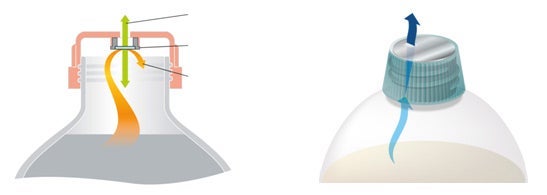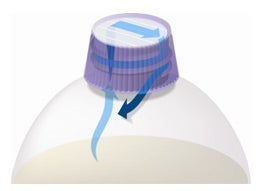FAQ for GORE® Packaging Vents
General Information
Hydrophobic membranes protect high surface tension aqueous liquids like water, and reduce pressure within the packaging. Gore's oleophobic ePTFE membranes provide protection not only to aqueous liquids, but also to lower surface tension fluids like oils, soaps and detergents.
A GORE laminate is constructed of a microporous GORE™ membrane consisting of an expanded polytetrafluoroethylene (ePTFE) layer, which is laminated on to a support material. The support material mechanically stabilizes the GORE membrane and creates the connection to the device housing during the integration process.
Yes. The microporous structures of GORE membranes enable gas exchange in both directions while blocking the flow of liquids. Bi-directional gas flow can depend on whether there is positive or negative pressure in the container relative to the external environment. Gore offers a range of materials with varying airflows depending on how quickly the package needs to vent.
It depends upon the product form and application. A hole in the cap is required when using molded components and two layer foam liners. A hole in the cap is not required when using a 3FL Cap Liner or Induction Liner. Gore’s global engineering team can help to recommend the appropriate product form that will work with your specific application.
For caps with a hole, gas passes through the microporous ePTFE membrane and escapes through the hole in the cap while stopping liquid and particles from entering the package. The microporous ePTFE membrane prevents pressure build-up by constantly equalizing the difference in pressure between the inside of the container and the outside environment.

For caps without a hole, gas passes through the microporous ePTFE membrane to an area above the membrane, which directs gases to the cap threads while stopping liquid and particles from entering the package. The microporous ePTFE membrane prevents pressure build-up by constantly equalizing the difference in pressure between the inside of the container and the outside environment.

Technical Information
The microporous structure of the GORE membrane enables gas flow even at the smallest difference in pressure. This means that unlike classic valve systems, such as mushroom valves, no response pressure is required to enable gas transport.
The airflow value in liters per hour (l/h), which can also be found in the product information, is a “dry” measured value, i.e. the vent has not been dampened by a liquid in advance. This allows the various GORE Packaging Vents to be evaluated relative to one another. The value can be used as initial selection criteria, but not the only one.
Direct contact with a liquid can significantly change the remaining airflow later on. It is therefore critical to not choose a vent based on the dry airflow performance only. An on-site application test must be performed for a new application or formulation change.
The resistance of the laminate to liquid penetration or leakage depends on the properties of the membrane, such as the size of the pores and the properties of the product in question, such as surface tension or viscosity. A liquid can enter or be pushed through a porous barrier from a certain given pressure. Due to the wide range of products and chemistries used in packaging, the values specified in the data sheets for GORE Packaging Vents should always refer to water as the reference liquid.
If liquid product covers the membrane surface of a GORE® Packaging Vent when a container is on its side or upside down, gas exchange cannot take place. In order for the vent to work, the gas in the container must be able to sit directly on the active surface of the GORE membrane.
GORE Packaging Vents D15 and D17 Molded Components are marked with an individual number on each part using a laser. This data enables traceability right back to the basic components utilized at the start of the Gore value-added chain. Thanks to the marking, a component can be individually distinguished and it can be ensured that an original GORE Packaging Vents Molded Component was used, even after use. In-depth traceability, complementary quality assurance measures, and airflow and visual tests provide the necessary safety for the packaging and transportation of hazardous goods.
Because all liquids are not the same! Even if you use a qualified container with a venting membrane to equalize pressure, the container can still leak. Passing the pressure test with water does not ensure that the membrane can prevent YOUR chemical formulation from leaking or spilling when exposed to real-world conditions. Every liquid formulation has a unique chemical make-up that results in significant variations in surface tension and viscosity. These properties translate to unique liquid entry pressure, most of which are very different from those of water.
Application information
There are a variety of different factors that need to be taken into account before we are able to recommend a packaging vent that it is suitable for your application. Key considerations include, but are not limited to: chemical composition of the packaged material, temperature fluctuations, altitude changes, and many more. To find out which vent is right for your application, please contact us.
The first GORE Packaging Vents were successfully used to ventilate hazardous goods over thirty years ago, particularly for peroxides and their formulations. Since then, the product range has been continually improved and adapted to meet a variety of requirements.
Some common end-use applications for our hydrophobic venting products are: dry products, powders and tablets, pool bleach, pool shock and products containing: bleach and water, disinfectants, hydrogen peroxide, and water.
Some common end-use applications for our oleophobic vents include: household or industrial cleaners, pesticides, liquid fertilizers, scented bleaches, and products containing: alcohols, degreasers, detergents, essential oils, fragrance, oils, solvents; and surfactants.
Sampling, pricing and ordering information
To obtain a sample, simply email us or call 1-800-637-4449 (USA) or 49-89-4612-2211 (Germany).
While Gore does offer some standard packaging vents, many of our solutions are uniquely tailored to meet our customer’s applications. We would be happy to provide you with a quote for a particular packaging vent, once we are able to understand the details of your application and have determined that there is a viable Gore solution.
Yes. The D15, D17 and D38 Molded Components are designed and optimized such that they can withstand drop tests as part of a closing and container system. In principle, however, approval can only be granted for an entire container, i.e. a container with closing system, to transport hazardous goods.
Gore sells vented cap liners, vented induction liners, and molded press fit vents that can easily be integrated into most caps and closures.
Gore does not sell vented containers; however Gore engineers a broad variety of packaging vents that can transform unvented plastic containers to vented plastic containers. In addition, Gore has built relationships with some of the world’s largest container manufacturers who are able to provide various container sizes, shapes, and designs.
Installation, handling and storage information
GORE Packaging Vents provide the flexibility to be installed manually for low-volume or frequently changing production, as well as fully automated installation for high-volume production.
Please contact a Gore representative to find out more about which method would be best for your application.
Please note that the membrane may be damaged if not handled correctly, which can lead to leaks. Therefore, please follow the following handling recommendations:
- Avoid touching, compressing, or squeezing the membrane.
- Wear latex-free gloves or finger cots when handling GORE Packaging Vents.
- Avoid contact with sharp objects.
- Check membrane compatibility prior to use with chemicals (according to our product information for application testing).
- When GORE Packaging Vents Molded components are used, the following guidelines are recommended:
- The venting hole in the cap should meet the recommended dimensions (ø 2 mm)
- The venting hole must not be blocked (e.g. when piling up containers, by splints, dirt, liquid or by wrapping the containers in foil).
- Please ensure that the press-fit dimensions correspond to the recommendations in the installation guidelines. The clamping edge should not be higher than specified so that it does not cover the ventilation holes of the vent. Otherwise, liquid could pool in front of the membrane and lead to a reduction of the venting performance.
- When GORE Packaging Vents Liners are used, the following guidelines are recommended:
- Use the recommended torque for installing the closure on the container. Otherwise the liner might be compressed too hard. This can result in a reduced venting performance.
- The liner should preferably be mounted in the cap with an undercut rather than gluing it. If glue has to be used though, the adhesion point should be as small as possible and in the center of the liner. It is recommended to use glue with high viscosity.
- When using GORE Packaging Vents Liners, which require a venting hole in the cap, please consider the following:
- The venting hole should meet the recommended dimensions (ø 2 mm)
- The venting hole must not be blocked (e.g. when piling up containers, by splints, dirt, liquid or by wrapping the containers in foil).
- The handling of the assembled product (e.g. closure with installed GORE Packaging Vent) as bulk good has to be tested individually.
Gore recommends storing products in their original packaging in a clean environment. The vents should avoid exposure to extreme temperatures and temperature fluctuations during storage.
FOR INDUSTRIAL USE ONLY
Not for use in food, drug, cosmetic or medical device manufacturing, processing, or packaging operations.